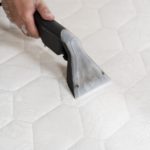Time was, you couldn’t move for pewter. This tin alloy was the material of choice for the vessels of millions of ale swiggers and mead quaffers up and down the land.
It may not be quite such a massively popular material nowadays, but you do still find it being used in ornaments and knick-knacks, so it’s helpful to know what to do with it when it gets tarnished or marked.
We’ll take a look at a couple of ways of cleaning it, one for slight marks and everyday buffing, the other for more serious shining.
Then, as a special treat for those with metallurgy maniacs out there, we’ll end with a quick look at what it actually is.
So, don’t get brassed off. Don’t get that zincing feeling. There’ll be a silver lining. First, here’s what to do to pewter.
Keeping Pewter Clean
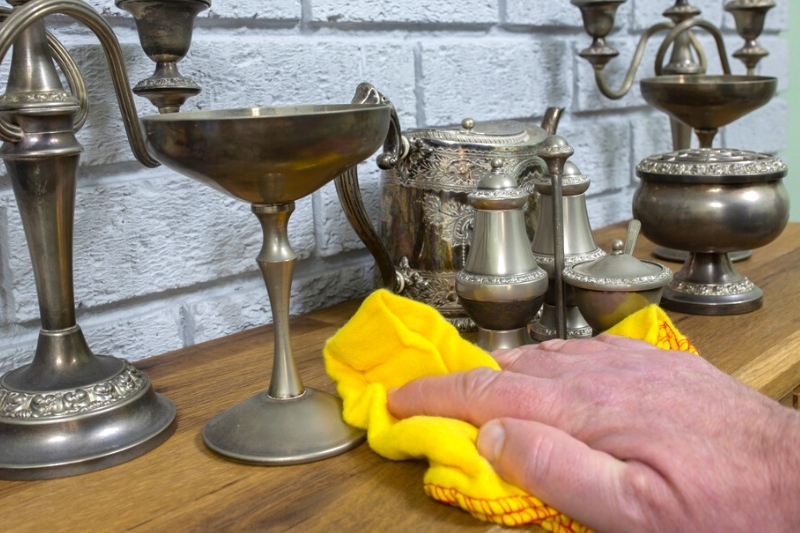
Although pewter is resistant to tarnish and rust, its surface can oxidise, which accounts for the dullness you often see in older pewter items. This variety is known as antique pewter.
There are other types (known as polished pewter and satin pewter), but whichever type you have, you can use the following methods to keep it clean.
The good news about this amazing alloy is that you can maintain its magnificence with a simple rubbing regime.
Use a microfibre cloth, and wipe back and forth in straight lines, never in circles (you can always tell if somebody’s used the circular routine, as, over time, you can see a round wear pattern in the metal’s surface; a linear pattern will blend far better with the metal’s sheen).
Here’s a tip for all pewter handlers: be careful. If you have a smaller item such as a teaspoon, it’s surprisingly easy to bend and/or break it with heavy-handed grabbing. So, keep your inner Uri Geller in its box and use gentleness.
If you need to clean pewter after food use, you can submerge it in warm water, adding a little washing-up liquid. Make sure you rinse well and dry with a soft towel.
Polishing Pewter

This method should just be used with polished pewter.
You can use a proprietary polish like Brasso, but make sure it says on the label that you can use it for pewter.
Note: Silver polish is usually unsuitable because it can attack pewter’s surface.
It’s equally effective and much cheaper to make a polish yourself from these simple household ingredients.
Mix 100g of plain flour with 100 ml of white vinegar. Apply the paste with a soft cloth all over the item, then leave it for 30 minutes to work its magic. Then rinse, dry and buff with a microfibre cloth.
If you’re dealing with some pewter that’s past its best and is heavily corroded, you might want to consider adding some salt.
This isn’t always advisable as salt is abrasive, so weigh up the cost-benefit before you add.
Another polish you can make is composed of linseed oil and rottenstone. But, let’s face it, you’re a little less likely to have either of these items just hanging around your home. Rottenstone? Yeah, I had to look that up. It’s powdered limestone.
Pewter Jewellery Care
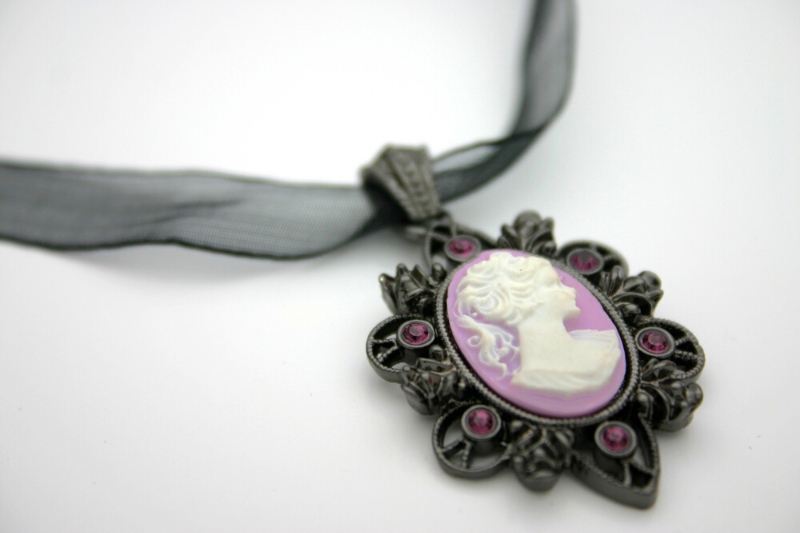
With most pewter jewellery being delicate, it can take special care. One very good technique is to dampen a soft cloth, then apply a drop of washing-up liquid.
Then apply it to the piece of jewellery, getting into all its nooks and crannies. Then rinse the cloth with cold water and go over the jewellery, getting rid of all the soap.
Change to a clean, dry, soft cloth to dry the piece off.
Again, make sure there are no ham-fisted antics here as pewter jewellery can be extremely soft (which is a property that attracts fine work craftspeople in the first place, of course).
You can use polish just as you would with other pewter items. Just make sure you only use a little and, again, rub lightly!
Tips on Pewter Care
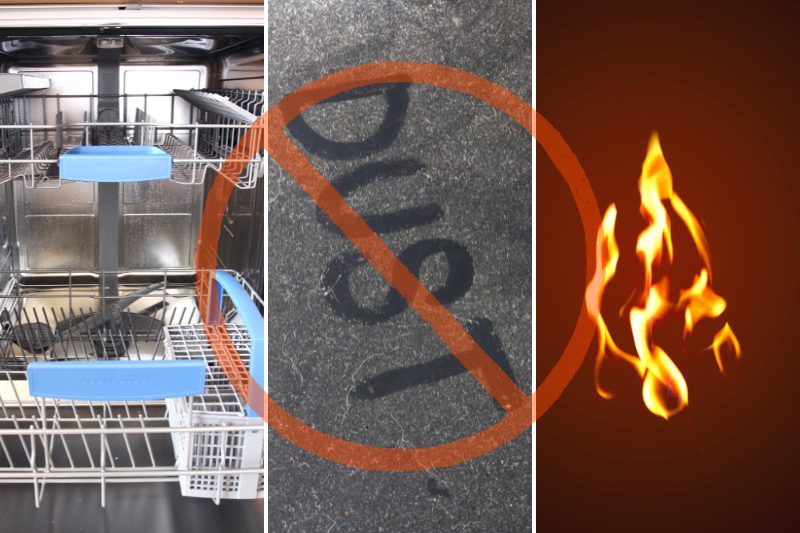
Don’t put it in the dishwasher
Never put pewter in the dishwasher. If you take away nothing else from this piece, make sure you remember this.
Pewter has a very low melting point, and a hot dishwasher session can result in a spoiled spoon.
Or, even worse, a twisted tankard (great name for a heavy metal band, but not such a great addition to your range of drinking vessels).
Protect pewter from dust
If you’ve got pewter ornaments on display, keep them behind glass so that they don’t attract dust. If they’re out in the open, give them a regular dusting to bring out their beauty and protect them from any particle ingress.
Keep it away from heat
Keep your pewter bits and pieces away from any heat sources, as they won’t like sustained warmth.
Store wrapped in paper
Keep jewellery and crockery wrapped in paper to prevent any scratching while being stored.
Use vinegar if you want to make it look antique
If you want to make your pewter look antique, try rubbing vinegar into it and leaving it for 20 minutes.
When you rub the vinegar off, you should possess a perfectly patinated piece of pewter.
Note: best to try this technique with a test piece first, just so you know what you’re letting yourself in for.
Clean with emery paper if all else fails
If you have a piece of pewter that refuses to respond to any of the above treatments, and you’re at your wit’s end, you can try a piece of fine-grade emery paper. Rub lightly all over.
Make sure you give it an even application. Then, when you’ve finished, try one of the above techniques.
Blend scratches using fine steel wool
You can restore scratched pewter to its best with the careful application of fine steel wool. By gently rubbing all over the affected area, you can blend the scratch into its surroundings.
What Is Pewter?
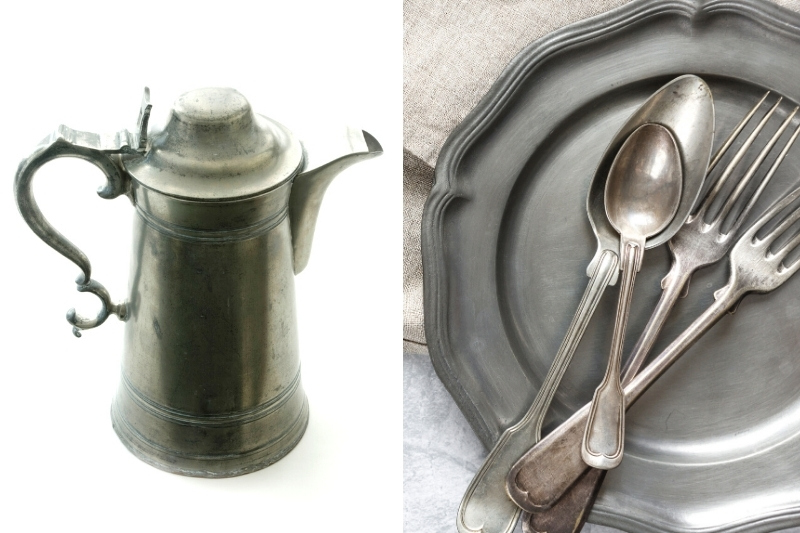
You’ll probably have seen a pewter tankard. Or you may even have one, if you’re the kind of person who likes to surround themselves with items from the days of yore, or you’re a character from a Dickens novel.
Either way, what you’re likely to be aware of is pewter’s historic use as the pre-eminent material for drinking vessels, due to its readiness for crafting and resistance to tarnish.
Unlike many metals, such as copper, which start off looking amazing but take a ton of care to keep them looking that way, pewter is an alloy that starts off looking good and pretty much stays that way.
Its use dates back 2000 years or so, back to the era of those renowned clever clogs, the Romans.
They were looking for a material that they could take with them as they made their merry way across Europe, duffing up the locals hither and thither.
They found that glass and earthenware were too fragile, and most metals too heavy or too prone to rust or other degradation to use for on-the-conquer crockery.
Pewter fitted the bill admirably, and before long they were also using it back home for decorative pieces to brighten up the villa.
Back then, pewter consisted of a mix of tin and lead. Lead’s not such a big hit in the cup and plate world now, due to its alarming tendency to kill the user.
Nowadays, pewter is made from a blend of tin, antimony, copper, bismuth and (sometimes) silver.
The key characteristics that this mix bestows are resistance to tarnish and a high level of malleability.
Cheers to Pewter

Kept in good condition, pewter is a truly beautiful metal. So, it’s worth knowing what to do with it to maintain its subdued charms.
As you’ll now know, you only need to give your pewter minimal amounts of care to carry on getting good-looking service from it for a lifetime or more. A quick rub and it’s good to go. Those Romans weren’t daft, you know.

Martin’s life revolves around films, dogs and food, but rarely all at the same time. At least two out of these three like to give clothes and furniture a hard time, and Martin enjoys discovering and writing about new ways to stop them doing their worst.

